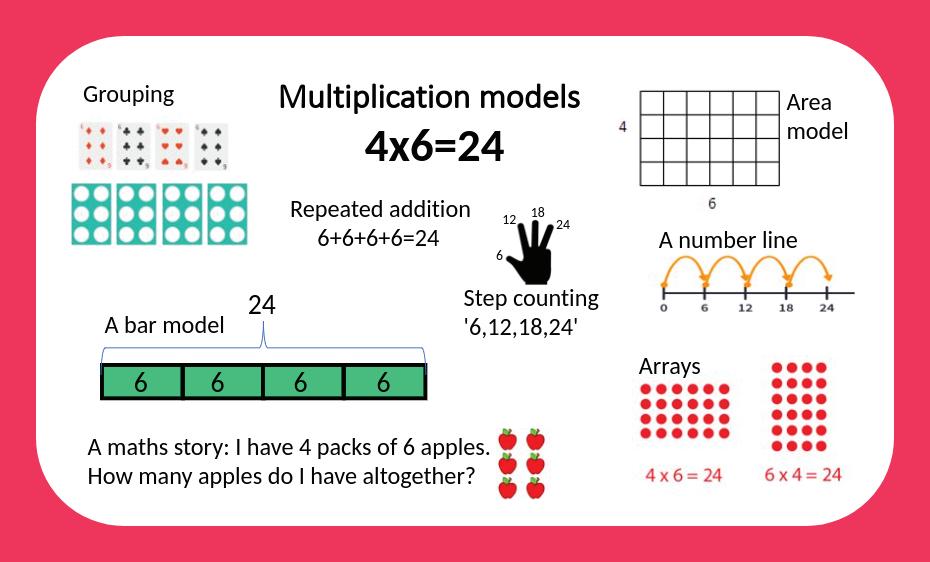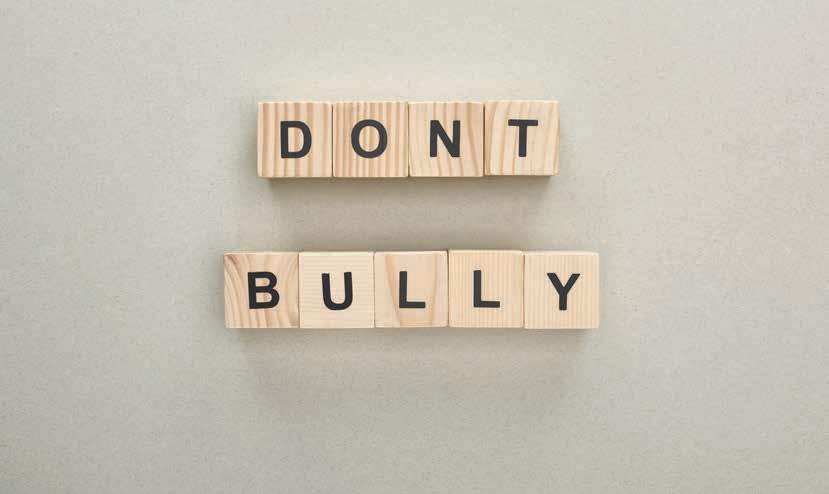
7 minute read
I love times tables
I tim es tab les
by Hari Neocleous
Advertisement
Learning times tables can be fun! Gone are the days where we learnt through fear in front of the dreaded times table wheel. I’m going to show you how you can help your child learn their times tables using pictures and objects you have at home.
In year two children learn their 2, 5 and 10 times tables. In year three they learn their 3, 4 and 8 times tables. By the end of year four, children need to know all of their times tables up to 12!
Conceptual understanding is important. This means having a deeper understanding of multiplication. Write down ‘4x6=’. What does this mean? It means ‘4 groups of 6’, ‘4 lots of 6’, ‘4 times 6’ or ‘4 multiplied by 6’. We can think of multiplication as grouping. 4x6 means four groups of six or six groups of four. It’s also repeated addition, we add the same number of objects again and again 6+6+6+6=24.
At home you can use arrays. Arrays are rectangular images, groups of objects arranged in equal rows. Imagine a Lego brick with 8 spots, that’s an array showing 2 groups of 4 or turn it the other way and it’s 4 groups of 2. Paint palettes, chocolate bars and chess boards are arrays. Go on an array treasure hunt and explore! Let’s learn the six times tables. Make twelve cards with 6 spots. Focus on 1x6 up to 5x6 fi rst. Show the fi rst card with 6 spots, count the 6 spots and write the number sentence above, ‘1x6=6’.

Then do ‘2x6=12’, ‘3x6=18’...each time adding another card.
Add some memory hooks too. So ‘1x6’ is a 6 on a dice. ‘2x6’ is doubling. For ‘3x6’ I might draw a tiny key and mention a gold key necklace from my 18th birthday. ‘4x6’ is 24 so I knock on the door, (a rhyme and action to make learning ‘stick’). ‘5x6’ is the same as ‘6 lots of 5’, so we fi nd a clock and count in fi ves, our hand points down as we stamp our feet and shout 30 minutes! It’s practical, there’s repeated addition, we have memory hooks and we have the number sentences. Count in ones fi rst, emphasising the sixth number. Then say, ‘let’s try counting in sixes... 6,12,18,24,30’. Write the answers (multiples) on cards, muddle them up and order. Put them on your staircase as you go up and down, counting in sixes before bedtime.
Continue this process up to 10x6..then fi nish with 11x6 and 12x6. Find ‘12x6’ by partitioning (splitting the number into tens and ones). Work out 10x6 then 2x6 and add the totals together, 60+12=72 To fi nish, practise counting in sixes on fi ngers and each elbow can be 11x6 and 12x6.
Be creative. Make it fun! Do something diff erent each day. Draw egg boxes and


ask, ‘how many eggs?’ Find yoghurt packs at the supermarket and ask, ‘how many?’ Use times tables songs. My favourite songs are from Mr Demaio’s YouTube channel. His 6 times table song is to the tune of Cheerleader (Uptown Funk is also great!)
Play bowling with bottles. Each time you knock a bottle it’s 6 points so count in sixes and see who wins each round.
Encourage your child to make connections too. If I know that 4x6=24 then I also know that 8x6=48, I used my doubles to help me here. If I know that 10x6=60 then I know that 5x6=30, here I’m halving the number of groups and halving the total. If I know 5x6 equals 30 then 6x6 means adding another group of 6 to get 36. We’re using one fact to get to a new fact. Children also learn division facts: 24÷6=4 and 24÷4=6
I’m a huge fan of game-based learning. Multiplication battle is an easy game to learn. Take a pack of cards, Joker=zero, Jack =10, Queen=11 and King = 12. Place a 6 in the middle. Take turns to turn over a card and multiply your number by 6. Whoever has the greatest total (product) swipes the 2 cards. Children can step count on their fi ngers. So, for 6x6 put 6 fi ngers up and count in sixes... 6,12,18,24,30,36.’ Practice leads to quick recall for most.
There are great apps and games online. I love Coconut Multiples on ‘Topmark games,’ children knock down coconuts which are multiples of 6. Check out the ‘1 Minute Maths’ app by White Rose Maths and the Curious Maths Subscription service for parents (fi nd me in the games section of course!)
I hope you can see that times tables can be fun. Keep it short. Practise regularly. Don’t forget to throw in a few ‘I love the 6 times tables’ or ’this one’s my favourite times table’. Be excited. Avoid comments such as ‘I’m bad at maths’ or ‘I hate maths’. And if your child’s homework is to learn their times tables don’t be afraid to ask teachers how. We are here to help.
Did you know?
Children in year four do a multiplication test in the summer. They have 6 seconds to type the answer. Times tables appear in many topics. If a child doesn’t know them, it slows them down in class. I agree that times tables are important, but I disagree with the six-second timings. This creates maths anxiety in some learners. We need to be mindful of the maths experiences we give our children and for some children, it’s ok to step count on their fi ngers to fi nd the answer. For ‘4x5’ they hold four fi ngers up and count in fi ves, ‘5,10,15,20’. Remember, we can’t all memorise them! Children learn in diff erent ways and that’s ok.

The impact of bullying on young people. What can be done about it?

By Marilena Andreou - Cognitive Behavioural Psychotherapist
Do you know someone that has been affected by bullying? This could be your child, a friend or a relative. Have you noticed that it has had adverse effects on their mental health? How could this affect their future academics?
Bullying is a behaviour by an individual or a group, which can be repeated over time, that intentionally hurts another person or group of people.
There are two types of bullying: physical and emotional.
Sadly, there has been an increase in bullying in young people since the rapid increase of new technologies, which has provided a new medium for bullying known as ‘cyber bullying’.
Some recent statistics indicate how common it is. For instance, a fifth of young people have been victims of bullying in the past year.
The prevalence in schools
• 29% of English secondary schools received reports of both physical and non-physical violence. • 13.9% reported that a student, parent or guardian had actually reported hurtful electronic postings on the internet (social media) about students. Unfortunately for those young victims, there is a huge impact on their mental health and education.
Strong research has shown that children that are bullied at the age of seven years old were less likely to be engaged in school three years later.
Furthermore, those pupils that are bullied at the age of 14 years old were firstly more likely to experience bullying at the age of 16, and secondly had significantly lower GCSE grades.
It is apparent that, for many of the young people that have experienced bullying at some point in their lives, this can trigger mental health difficulties.
Impact of bullying on young people
Bullying can make an individual:
• less confident • lonely • desire to avoid school or college • more at risk of depression and anxiety • experience the effects in later adolescence and adulthood • suffer diminished self-esteem.
What can be done about bullying?
• Encourage the child or young person to report the incident(s) to a teacher. By opening up and informing the school, they should be able to put some serious actions into place to prevent future bullying. • Encourage the child or young person to confide in a family member, if there is anything that someone has done to upset them at school or college or even outside of school. This is important as they may not even view this behaviour as bullying. • Look out for some warning signs such as the child not wanting to go to school, or refusing to. • Parent and guardians can limit their social media usage or ensure they are safely speaking to others online. • Cognitive Behavioural Therapy (CBT) can be effective for treating individuals who have been bullied and consequently have developed mental health problems such as anxiety and depression.
In conclusion, although bullying is a significant problem for some young people, it is crucial to note that there are things that can be done to reduce further incidents from happening. Furthermore, if parents, guardians and teachers can work collaboratively together, this can help to reduce the impact of bullying.







